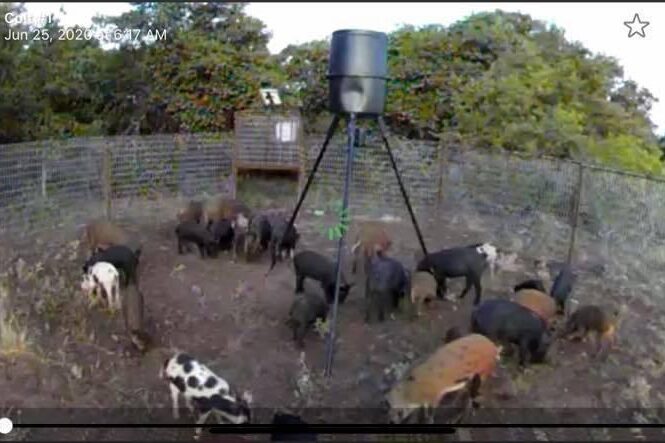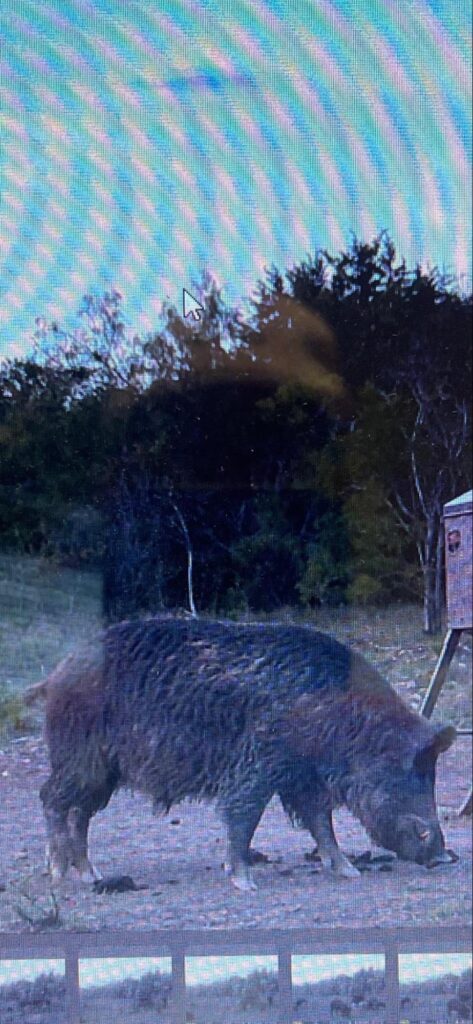Pigging Out at PK
Story by Bob Kaspar

Live camera footage trapping hogs courtesy of G93 Outdoors
With few natural predators, opportunistic feeding habits and the ability to reproduce quickly, the feral hog population has exploded in the Lone Star State, according to data provided on the Texas Parks & Wildlife website https://tpwd.texas.gov/huntwild/wild/nuisance/feral_hogs/.
“From 1982 to 2016, the wild pig population in the United States increased from 2.4 million to an estimated 6.9 million, with 2.6 million estimated to be residing in Texas alone,” the website noted.
Across the state, wild pigs are sticking their snouts where they don’t belong, rooting up crops, pastures, and residential landscapes. The Texas Parks & Wildlife website pointed to studies conducted in 2016 and 2019 that estimated the annual loss to agriculture in the state at more than $118 million.
In typical Texas fashion, though, landowners are fighting back, and a burgeoning industry for hunting, trapping and cooking feral hogs is beginning to emerge.
Wild pigs are not native to North America. They are descendants of domesticated pigs that were first brought to the West Indies in 1493 by Christopher Columbus. In 1539, Spanish explorer Hernando de Soto introduced these pigs to the U.S. mainland as a food supply during his journey to the coast of Florida. The pigs often were left behind by these New World explorers as they traveled farther westward. Those omnivorous animals thrived on the abundant natural food supply and quickly became feral.
In the 1890s, wild Eurasian boars were released into North America as a new hunting quarry. Though originally confined to fenced hunting preserves, these crafty creatures soon escaped and also became feral.
Feral pigs are similar in appearance to domestic pigs but typically have longer tusks and a thick, bristly coat. Their coloration is highly variable, as a modern wild pig is likely a product of substantial crossbreeding. Boars, or adult male pigs, routinely tip the scales at 200 to 220 pounds, while adult females, called sows, typically weigh between 150 and 170 pounds.
Multiple sows and their offspring travel in large groups called “sounders,” and each sounder can comprise dozens of pigs. Boars, on the other hand, typically live a solitary life but will occasionally join up with other males in a group known as a “bachelor pack.”
Population dynamics are a primary factor in the booming feral hog population. Sows can have multiple litters in one year, with an average of four to six offspring per litter. The average gestation period is about 115 days, and sows typically breed every year.
Hogs have an omnivorous diet and are opportunistic feeders. They mainly consume a wide variety of plants, such as acorns, roots and bulbs, as well as cultivated crops. Rooting is a primary indicator that hogs are feeding in a particular area. It’s an extremely destructive behavior that destroys ground vegetation and increases erosion while reducing the nutrient load within the soil.
Hog damage is no longer just a rural issue, either. As their population expands, hogs are now moving into residential neighborhoods, rooting up lawns and landscapes.
More and more Texans are making the best of a bad situation, however, and a new industry is evolving around these invasive beasts. One would be hard-pressed to find a hunting ranch in Palo Pinto County that doesn’t offer hog hunts, and these hunts can fetch upwards of $250 per hog.
There’s also money to be made trapping hogs, and Colt Dorr, owner of G93 Outdoors, realized there was an opportunity in that segment of the market about four years ago.
“It kind of turned into a serious gig when more housing developments around the lake started getting put in,” he said. “People with more money were buying bigger and fancier homes, and realized that their yards didn’t stand a chance. That’s when I made some investments in large, cellular traps, where you can really put a hurting on the numbers.”
But it’s not just the money that motivates enthusiastic hog hunters such as Dorr.
“Pigs are probably, outside of a mountain lion, the hardest wild animal that an outdoorsman can pattern to hunt,” he said. “They have no pattern.”
The key to success, Dorr said, is cellular phone service. With the service, he said, his traps can be remotely activated.
Once Dorr has established a location where the pigs are foraging, he baits that area for several days and watches the hogs’ movements via a live camera.
“Once the pigs start to get comfortable with that spot that I’ve been feeding, I’ll start to put the trap up over the course of a couple of days,” Dorr said. “I’ll take my time.”
By setting it up in small increments, the trap can be constructed without arousing any suspicion from the hogs.
“So, basically, by the time those traps are fully set, the pigs are still feeding confidently and walking through the gate to get to the feed,” Dorr said. “I can then close the trap remotely via cellphone.”
Using this method, Dorr said he’s been able to trap up to 58 pigs at once.
Although many hunters aren’t interested in harvesting the meat from the pigs they shoot, Dorr has been able to find an international market for this Palo Pinto County nuisance animal.
After the pigs have been trapped, they are loaded live onto a trailer and sold to local buyers. These buyers will then feed the pigs for a month or so to put some more weight on them before eventually selling them to a processor in Fort Worth. From there, the hogs are butchered and sold into European markets, where wild hog meat is in high demand.
“The wild meat and wild pigs that are caught here in Palo Pinto County are then dispersed all over the world as a delicacy meat,” Dorr said.
Diners in America can also experience this international delicacy, and with minimal effort and some care in storage, wild hogs can yield delicious, lean pork that rivals anything from the grocery store.
Once meat from a hog has been harvested, it should be packed into a cooler full of ice, with at least a cup of rock salt sprinkled on top. The meltwater should be drained from the cooler every day before being topped off with more ice, and this routine should be carried out for a minimum of three days. The end product will be an extremely tender and lean pork loin that’s perfect for the grill, smoker or slow cooker – or an internationally renowned restaurant menu.

